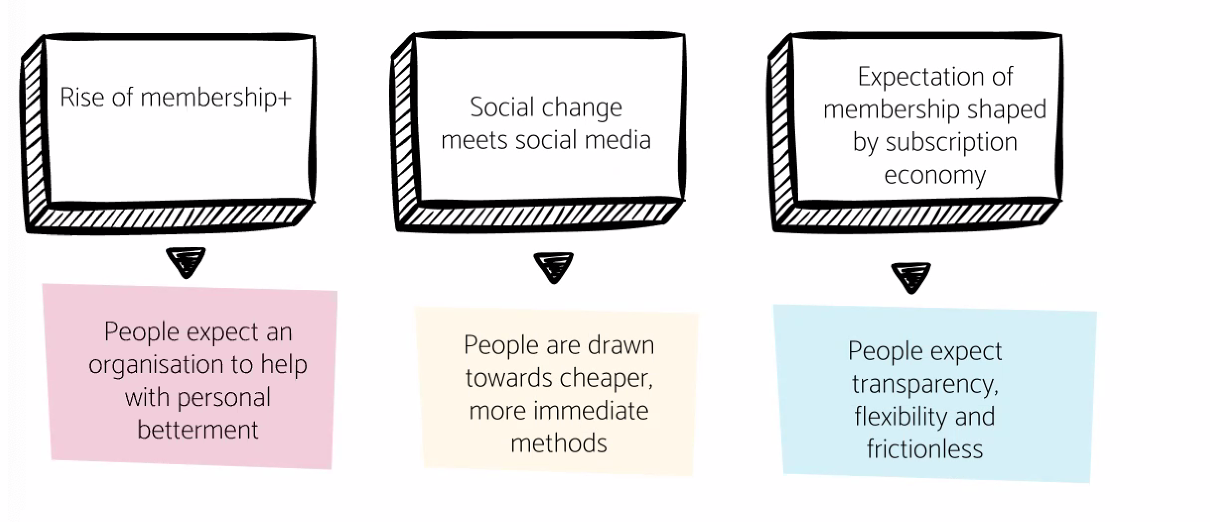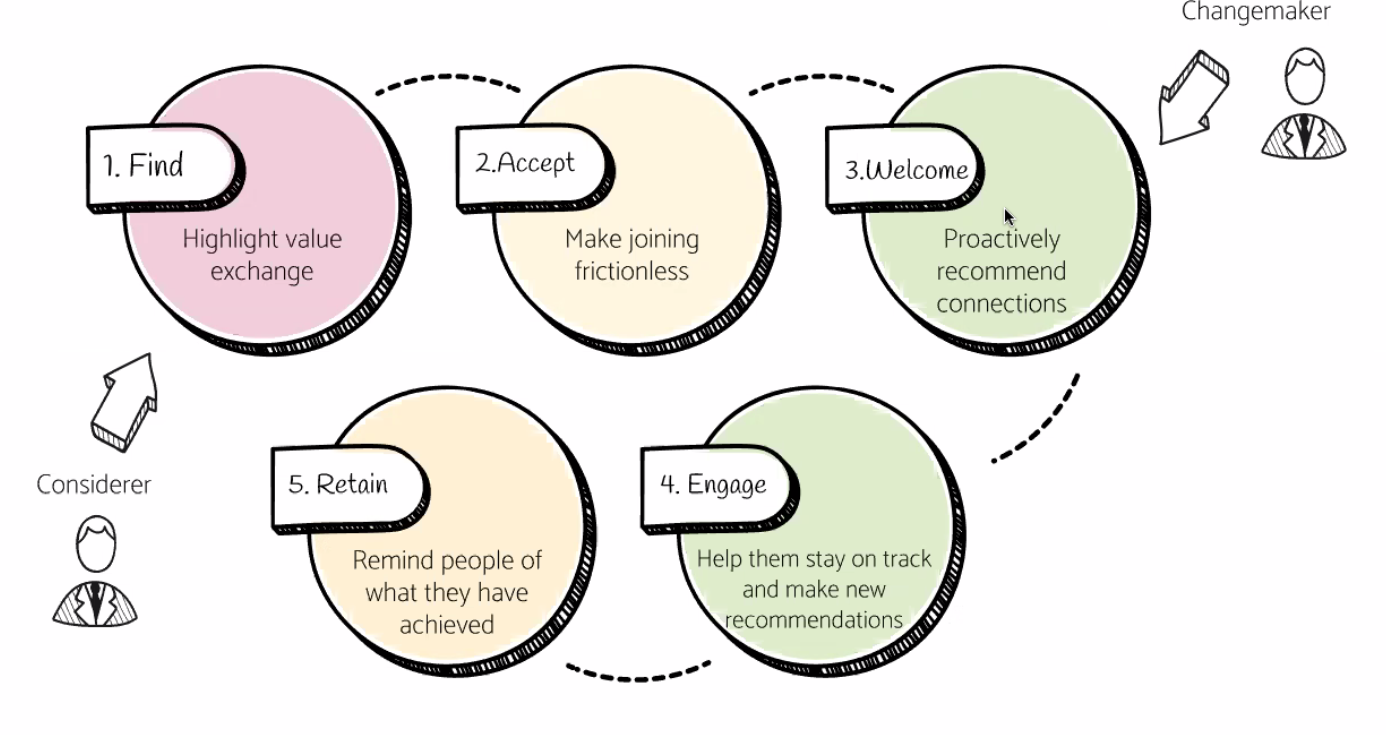The RSA’s inaugural Digital Summit was held in October with the ambitious aim of transforming how Fellows engage with the RSA.
The group of 60 Fellows and guests explored six facets that are key to this transformation and Jemima Gibbons wrote a great live blog that gives an overview of the day.
I want to focus on the Navigator breakout session, which focused on how Fellows find, navigate and ultimately engage with the RSA platforms and content.
The session started by our facilitator, Charles Veal, who prompted us to think about what we mean by digital, sparking a wide-ranging intro conversation. We all broadly agreed that digital must be human-centric to be valuable, blending people, culture and technology - too often tech leads without taking the human elements into account.
The challenge
After intros, Helena Blackwell laid out a core challenge:
The RSA has ‘buried treasure’ in its online presences - a wealth of contacts, platforms and events - yet today’s changemakers rely on a diverse range of sources - locally and globally - to get things done.
This challenge is being propelled by Fellows’ changing needs, behaviours and expectations.

To help bring these to life a bit, think about the membership+ of Soho House, where nothing is too much trouble. See how social media dramatically expands the awareness and impact of social change movements, such as Black Lives Matter. Think about how consumer expectations have expanded hugely looking at the experience of Netflix and the connected services of a brand like BMW that goes way beyond the physical car.
The vision
To challenge us to think big and broad about how we can make members matter, Helena’s vision drew from a customer journey model. She sketched out a Fellow’s journey, from proposed consideration to retention with key needs each stage of the journey.

New Fellow experience is key
Our discussion kicked off with the needs of newly joined members and it was jointly agreed that new Fellows are drawn to the RSA because they deeply want to make a difference - what an amazing start and there’s so much opportunity to put that enthusiasm to good use by helping them make meaningful connections with other Fellows.
Peter Clitheroe, who sits on the nominations panel, sees 50-100 applications per week and noted that most come with a real spark and are excited to join. But it was acknowledged that this excitement isn’t well translated into the experience. We speculated that new joiners become quickly confused about what to do next and how to navigate.
We must ensure that becoming a Fellow isn’t like joining a gym, starting with good intentions that then fizzle out.
Meaningful connections make the magic happen
We questioned how to better spark connections and create micro communities. At the most basic level, the bio section in a Fellow’s profile would be the natural starting point, but it often isn’t filled out (what’s it used for anyway?) and there’s no smart way of finding other Fellows like you.
Sanjay Varma shared his experience with YPO, using smart AI to help make valuable connections - it certainly would allow for more dynamism and lighter touch connections to be made in an automated way. It requires a critical mass for it to be valuable, but when it’s up and running, it’s frictionless.
Until we are able to fully marry systems with Fellows’ needs, though, we should start with a light-touch, accessible approach to forging connections. This could play out in a number of ways. Duncan Lawie suggested “light bite” 30 minute discussions between randomly chosen Fellows. Other thoughts included a buddy system and even virtual Slack coffee for members looking for collaborators. The key is to start quickly and simply.
Moving from a product to a service
The latter part of our discussion focused on the digital experience and website - is it a product or a service? We felt that if the website enabled connections in a human-centric way, it would become a service, creating far more value than it currently does. We know that, currently, it’s a product with tremendous content depth but that’s terrible to navigate.
So how can the website create permission for Fellows to be active and to become the changemaker they aspire to be? A great first step is to create more personalised experiences so that Fellow’s get tailored information in manageable amounts.
Another step is for Fellows to self-select what they want and when, where currently RSA staff are providing much of this service.As Heleana suggested, there needs to be a clear value exchange between RSA staff and Fellows, so that they can self serve and be far more active.
Mapping and sweating current capabilities
Much of the future-focused thinking requires platform support to automate and layer in AI. But it’s clear there is already a good foundation with the likes of EpiServer, Salesforce and Pardot.
Mapping the technical landscape and understanding functionality and gaps will help identify what is being underutilised, what can be expanded upon and where we need to bring in something new.
How do we best design a solution?
We strongly feel that a solution should be designed and governed by a group drawn from RSA staff and Fellows - who are ultimately the end users. This is something that should be worked through early on so there are clear roles and responsibilities.
Key principles to drive future thinking
With all the richness of the session, there were some principles we agreed on that I wanted to end with and ensure they’re baked into the next phase:
- Use human-centred design
- Be iterative and outcome focused
- Ensure collaboration between Fellows and RSA staff and volunteers
- Think like a system, act like an entrepreneur
- Use open source where possible - less developing, more integrating
And one final thought. While this session dug in deep on how to engage Fellows, we also must work out how to drive consideration and drive new members. We didn’t scratch the surface of that in our session in the end, which is a shame. But it’s the first, and not insignificant, hurdle to membership that we shouldn’t discount.
Related articles
-
Working towards an improved Fellowship experience
Blog
Lucy Griffiths FRSA
The Fellowship Roadmap project commenced in March 2020 with the aim aim of better understanding the RSA Fellowship’s needs.
-
Announcing the Covid-19 Catalyst Award funded projects
Blog
Kimberley Staines
20 impactful projects run by RSA Fellows and funded by the RSA to respond to the effects of Covid-19.
-
RSA Fellowship Councillors: helping shift the dial
Blog
Peter Clitheroe FRSA
Peter Clitheroe FRSA, Fellowship Council Deputy Chair, shares his experience of the role ahead of the 2020 Council elections.




Be the first to write a comment
Comments
Please login to post a comment or reply
Don't have an account? Click here to register.